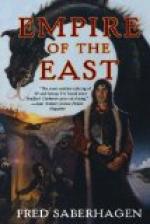Prince Nicolas is said to know the name of every one of his subjects, and will accost him by it. This is doubtless a great exaggeration, and probably means that he knows personally all those who fought under him in the last war, when the nation was considerably smaller than it is now.
No man is too humble but that the Prince will stop and speak to him, and ask him how the world is using him. The man rarely goes empty-handed away. In these latter days the Prince is not so open-handed as formerly, neither does he make so free with his presence, but still it is no difficult thing for any of his subjects to obtain an audience. He will stop a man at haphazard on the road and examine his weapons, and woe betide him if his revolver is carried empty. Every chamber but one must be loaded.
A characteristic instance of the Prince’s observancy was once given in Cetinje. An incongruous habit is creeping into the country of carrying a huge cotton umbrella in the great heat. The Prince met a man carrying one open, and promptly broke it over his head, saying—
“Art thou a hero, to carry a woman’s sunshade?”
For even to-day the youngest man will maintain that he is a “hero” by right of ancestry, and has no doubt of his capability to act up to the traditions of his country in the event of war.
The national costume is worn by all, and in the richer classes is very gorgeous. The combination of colour is in exquisite taste. There are many variations, but a description of the gala uniform will suffice.
The cap, or “kapa,” is the same for Prince and peasant. It is red with a deep black border, which only leaves a small crown of the foundation colour. On this crown in one corner are the letters “H.I.” (in Latin characters “N.I.” or Nicolas 1st) and five semicircles in gold. The explanations as to the meanings are slightly different. Both say the black border is symbolic of mourning for the losses at Kossovo, while the five lines are explained either as signifying the five centuries which have elapsed since that terrible battle or as symbolic of a rainbow—the sign of hope that one day the glories of the old Serb empire will be restored. The red crown signifies “the field of blood,” as the Hebrews have it. Furthermore, the different insignia of rank are worn on the rim of the cap, from the double eagle and lion of the senator in brass, the different combinations of crossed swords of the officer, to the simple star of lead of the corporal.
The costume consists of a “dzamadan,” a red waistcoat, embroidered with gold or black silk—the former on gala occasions—over which the “gunj” is worn, a long, white or very pale blue coat, cut so that the breast is left open and free. Another sleeveless jacket is worn, again, over the gunj, called the “jelek,” and is a mass of heavy gold and silk embroidery, quite stiff in fact, and a marvel of beautiful tracing and patterns.




